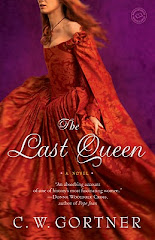 est installment, Crispin finds himself again in danger when he warily takes on his most recent client, Jacob of Provencal, a Jewish physician at court. Though all Jews were expelled from England nearly a century before, Jacob has hired Crispin to find stolen parchments that might be behind the recent savage murders of young boys -- parchments that someone might have used to bring forth a demon which now stalks the streets and alleys of London.
est installment, Crispin finds himself again in danger when he warily takes on his most recent client, Jacob of Provencal, a Jewish physician at court. Though all Jews were expelled from England nearly a century before, Jacob has hired Crispin to find stolen parchments that might be behind the recent savage murders of young boys -- parchments that someone might have used to bring forth a demon which now stalks the streets and alleys of London.Jeri has kindly offered this guest blog post to celebrate the October 12 release of The Demon's Parchment. Please join me in welcoming her to Historical Boys!
The Four Humors
By Jeri Westerson
By Jeri Westerson
No, this is not about the Marx Brothers. We don’t mean humor as in “ha ha” but humors as in exhalations of the damp variety. We are talking, well, bodily fluids. So, erm, why are we talking bodily fluids on this nice, clean blog, you may be asking? Because we are talking about my medieval mystery series and you can’t talk about things medieval without talking about bodily fluids…um, I mean Humors.
This was an ancient theory of physiology concerning one’s health and character. Indeed, one’s very soul might be in trouble if these four humors were not in balance. The four humors are Blood, Yellow Bile, Phlegm, and Black Bile, which were also associated with the four elements: air, fire, water, and earth. You see, to the medieval mind, the spiritual was bound up with the earthly. It all worked together.
This was an ancient theory of physiology concerning one’s health and character. Indeed, one’s very soul might be in trouble if these four humors were not in balance. The four humors are Blood, Yellow Bile, Phlegm, and Black Bile, which were also associated with the four elements: air, fire, water, and earth. You see, to the medieval mind, the spiritual was bound up with the earthly. It all worked together.
So each humor  reflected a particular color, if you will, of the body and spirit, and represented a good or bad constitution. These humors gave off vapors that went right to the brain and changed the temperament of the person.
reflected a particular color, if you will, of the body and spirit, and represented a good or bad constitution. These humors gave off vapors that went right to the brain and changed the temperament of the person.
Blood, for example, was a hot and moist environment and was associated with the element air. If you had balanced blood you were “sanguine” and prone to an amorous and generous temperament. Too much and you might go overboard and needed bleeding. Not enough and they would fill you up with red wine, which looked like blood (they were big into stuff that looked like other stuff. It seemed to make sense to them.)
Yellow bile was hot and dry and associated with fire. Too much yellow bile and you were “choleric” and tended toward violence and vengeance. Phlegm was cold and moist and associated with water. You were “phlegmatic” if you had too much of this and were dull, pale, and cowardly.
 reflected a particular color, if you will, of the body and spirit, and represented a good or bad constitution. These humors gave off vapors that went right to the brain and changed the temperament of the person.
reflected a particular color, if you will, of the body and spirit, and represented a good or bad constitution. These humors gave off vapors that went right to the brain and changed the temperament of the person.Blood, for example, was a hot and moist environment and was associated with the element air. If you had balanced blood you were “sanguine” and prone to an amorous and generous temperament. Too much and you might go overboard and needed bleeding. Not enough and they would fill you up with red wine, which looked like blood (they were big into stuff that looked like other stuff. It seemed to make sense to them.)
Yellow bile was hot and dry and associated with fire. Too much yellow bile and you were “choleric” and tended toward violence and vengeance. Phlegm was cold and moist and associated with water. You were “phlegmatic” if you had too much of this and were dull, pale, and cowardly.
Are you sensing a theme here? That some of the vocabulary we use all the time had its origins in medieval medicine? Yeah, you’d be right. Sort of. This theory of the humors or humorism came down to us from the Greeks, Hippocrates in fact, but the medievals didn’t see too much wrong with these ideas and continued with this form of diagnosis well into the Renaissance. Black bile was cold and dry and was associated with earth. Too much black bile made you “melancholic” and gluttonous, lazy, and sentimental.
It was a quick way to diagnose your problems. If you were easily angered, then it was too much yellow bile and meant your gall bladder (certain organs were also associated with each humor). The best way to help you out was to diagnose and treat. Bloodletting to keep the liver healthy. Emetics and purges for the other three. For a diagnoses, there was also a lot of sniffing, examining, and tasting of urine.
Ah, those were the days.
The Boston Globe has called Jeri Westerson's hero, “A medieval Sam Spade, a tough guy who operates according to his own moral compass.” Her 2008 debut from St. Martin’s Press, VEIL OF LIES, garnered nominations for the Macavity Award for historical mystery and the Shamus Award for Best First PI novel. Her second, SERPENT IN THE THORNS, is also a 2010 Macavity finalist and a finalist for the 2010 Bruce Alexander Historical Mystery Award. To learn more about Jeri and her work, please visit her website.
It was a quick way to diagnose your problems. If you were easily angered, then it was too much yellow bile and meant your gall bladder (certain organs were also associated with each humor). The best way to help you out was to diagnose and treat. Bloodletting to keep the liver healthy. Emetics and purges for the other three. For a diagnoses, there was also a lot of sniffing, examining, and tasting of urine.
Ah, those were the days.
The Boston Globe has called Jeri Westerson's hero, “A medieval Sam Spade, a tough guy who operates according to his own moral compass.” Her 2008 debut from St. Martin’s Press, VEIL OF LIES, garnered nominations for the Macavity Award for historical mystery and the Shamus Award for Best First PI novel. Her second, SERPENT IN THE THORNS, is also a 2010 Macavity finalist and a finalist for the 2010 Bruce Alexander Historical Mystery Award. To learn more about Jeri and her work, please visit her website.













1 comment:
EEewwwww - gotta love those body fluids, especially in the capable hands of Jeri Westerson. If you think she is knowledeable about THIS, just wait til you read one of her exciting, action-packed, atmospheric, researched (but only to make the story more fascinating), and VERY well written books. (And no, she didn't pay me to say that!)
Post a Comment